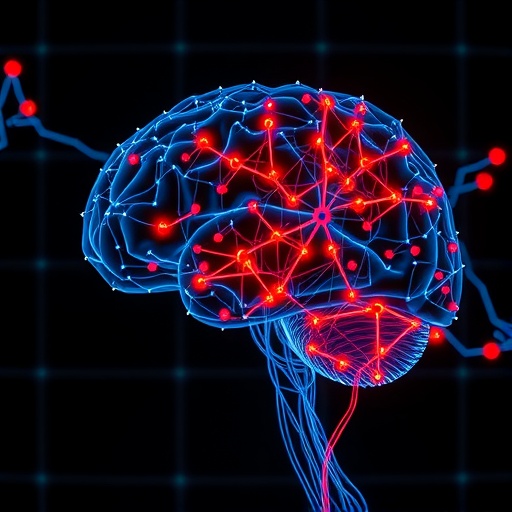In a groundbreaking study soon to be published in BMC Psychiatry, researchers have unveiled the intricate neural network dynamics underlying response inhibition deficits in Major Depressive Disorder (MDD), shedding light on their potential role as biomarkers for antidepressant treatment outcomes. This investigation advances our understanding of the neurophysiological foundations that govern why some patients respond robustly to antidepressant therapies while others remain resistant, a critical issue that has long challenged clinicians and neuroscientists alike.
Major depressive disorder, a condition marked by pervasive sadness, loss of interest, and cognitive impairments, has also been linked to fundamental deficits in response inhibition — the brain’s capacity to suppress inappropriate or unwanted actions. While previous studies have acknowledged this impairment, the precise neural correlates and their connection to therapeutic responsiveness have remained elusive. This latest research addresses this gap by combining cognitive neuroscience methods with advanced neuroimaging techniques to trace network-level brain activity during response inhibition tasks.
The research cohort comprised 149 participants, featuring 72 clinically diagnosed MDD patients alongside 77 healthy control subjects. Participants were engaged in a Go/No-go task, a well-validated experimental paradigm designed to probe inhibitory control by requiring them to respond or withhold responses under timed conditions. Concurrently, magnetoencephalography (MEG), a neuroimaging technique capable of capturing millisecond-scale neural oscillatory activity across the brain, was employed to map the functional connectivity patterns.
One of the key methodological strengths of this study lies in its use of beta-band oscillatory connectivity analysis. Beta activity, spanning roughly 13 to 30 Hz, has been strongly implicated in sensorimotor integration and cognitive control processes, making it an ideal frequency range to investigate response inhibition mechanisms. By analyzing whole-brain connectivity within this beta range, the researchers could pinpoint the precise large-scale networks implicated in impaired inhibitory function.
The findings revealed that patients with MDD exhibited significant hypoconnectivity predominantly within a right-lateralized network centered around the inferior frontal gyrus (IFG), a brain region critically involved in inhibitory control. This diminished connectivity correlated with impaired task performance, reinforcing the importance of the IFG’s role in orchestrating response suppression. Crucially, this alteration was not present in healthy controls, underscoring its specificity to depressive pathology.
Further stratification of the MDD group into responders and non-responders based on clinical improvement—defined by a minimum 50% decrease in depressive symptoms over four weeks of antidepressant treatment—yielded additional insights. Non-responders demonstrated markedly reduced functional connectivity within a left-dominant frontoparietal network, particularly involving the superior parietal gyrus and orbitofrontal cortex. This left-lateralized disruption was absent in both responders and healthy individuals, suggesting distinctive neural circuit pathology that may underlie treatment resistance.
These observations challenge the conventional notion that response inhibition deficits are uniform across all depressed patients, indicating instead a nuanced heterogeneity in neural dysfunction. The compromised connectivity in the frontoparietal network, especially in regions associated with executive function and decision-making, highlights a potential decompensatory mechanism where the brain’s capacity to adaptively respond to pharmacotherapy is impaired.
From a clinical standpoint, the ability to predict antidepressant response through neural connectivity biomarkers represents a transformative advancement. By identifying patients likely to be non-responsive early in treatment, clinicians can tailor interventions more effectively, possibly opting for alternative therapies such as neuromodulation or psychotherapy sooner, thereby reducing trial-and-error prescribing and associated morbidity.
The integration of MEG with cognitive paradigms exemplifies a powerful approach to dissecting the temporal and spatial dynamics of brain function. Unlike fMRI, which offers high spatial but limited temporal resolution, MEG captures rapid neuronal oscillations with exquisite timing, enabling the detection of dynamic network interactions critical for inhibitory control that might otherwise remain obscure.
Moreover, focusing on beta-band networks aligns with growing evidence linking oscillatory dysfunction across various psychiatric disorders to symptom manifestations and treatment responses. These neural oscillations facilitate communication across distributed brain regions; thus, their disruption can lead to pervasive cognitive and affective impairments. Understanding such mechanisms in MDD could pave the way for circuit-based interventions targeting specific frequency bands.
The study’s robust sample size and rigorous stratification criteria enhance the generalizability of its conclusions. Nonetheless, further longitudinal investigations are warranted to determine whether these connectivity patterns precede symptom onset or represent consequential adaptations. Additionally, examining the impact of different classes of antidepressants on these neural circuits could elucidate distinct pharmacodynamic profiles.
In sum, this research elucidates a complex neural signature associated with impaired response inhibition in MDD, linking aberrant connectivity patterns to antidepressant treatment outcomes. It highlights the critical role of large-scale frontoparietal and frontal networks in mediating cognitive control and their dysfunction in predicting therapeutic resistance. These insights herald a promising avenue for precision psychiatry, where neural network biomarkers inform personalized treatment strategies, ultimately improving patient prognosis and quality of life.
As the psychiatric community continues to grapple with the heterogeneous nature of depression, studies like this illuminate the path toward mechanistically informed interventions, underscoring the significance of large-scale neural network assessment. Future clinical protocols may well integrate brain connectivity profiling alongside traditional clinical evaluations to optimize and expedite effective care for individuals battling major depressive disorder.
Subject of Research: Neural network dynamics of response inhibition and their association with antidepressant treatment response in Major Depressive Disorder.
Article Title: Large-scale neural network correlates of response inhibition associated with antidepressant response in major depressive disorder.
Article References:
Liu, H., Xia, Y., Wang, X. et al. Large-scale neural network correlates of response inhibition associated with antidepressant response in major depressive disorder. BMC Psychiatry 25, 866 (2025). https://doi.org/10.1186/s12888-025-07286-1
Image Credits: AI Generated




